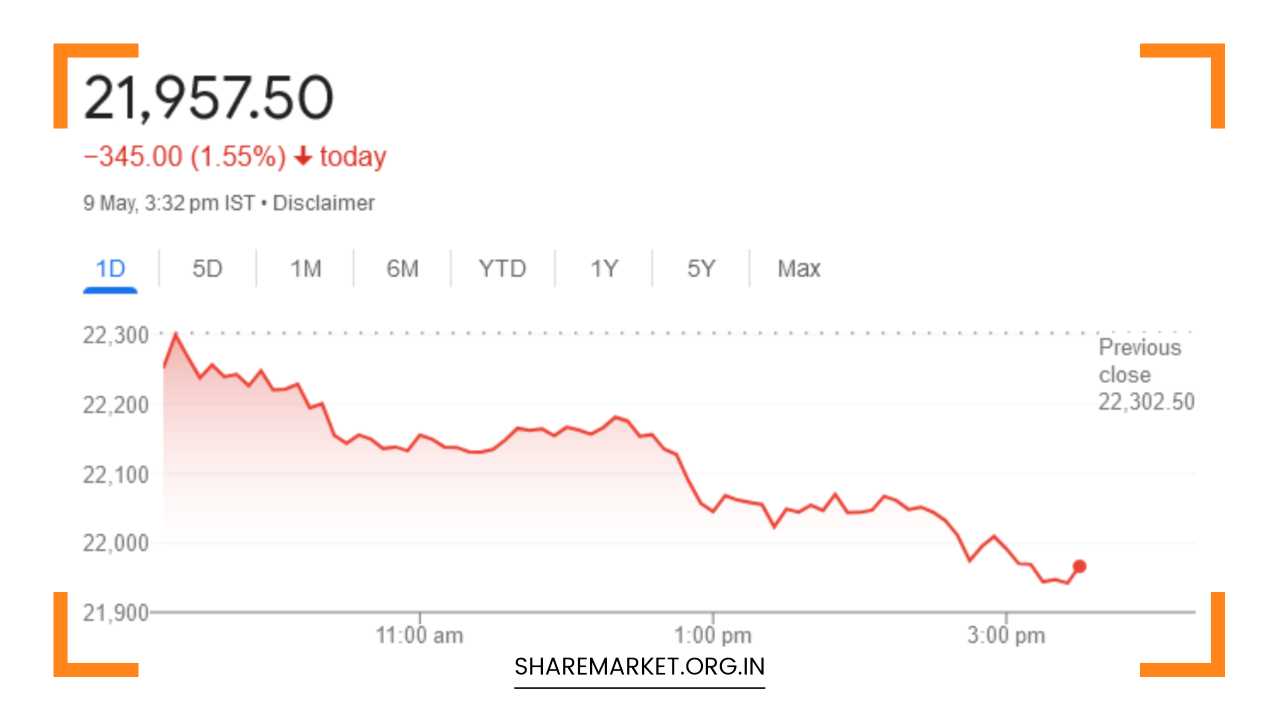Nifty Weekly Expiry Triggers Sell-Off; Tomorrow Nifty Prediction

Tomorrow Nifty Prediction
Nifty Slides on Weak Expiry, Volatility Expected to Persist: A Deeper Dive
Market Jitters on Nifty Expiry Day
The Indian stock market experienced a turbulent day on [Date], coinciding with the Nifty weekly expiry. Heavy selling pressure gripped most sectors, leading to a significant decline in key indices. This article delves deeper into the factors driving the market weakness and explores what lies ahead for investors.
Broad-Based Sell-Off Dampens Sentiment
All sectors, except for BSE Auto, witnessed a decline, reflecting a broad-based sell-off. The benchmark indices, Sensex and Nifty, fell roughly 1.5%, closing at 72,404 and 21,958 respectively.
This weakness translated into a substantial drop in market capitalization, with the BSE market cap shedding a staggering Rs 7.56 lakh crore on the day.
The decline extends a disappointing trend for the month, with the total market cap on the BSE shrinking by Rs 15.36 lakh crore in May alone.
The selling pressure was particularly pronounced in the mid-cap and small-cap segments, with the BSE Midcap and Smallcap indices plummeting by more than 2%.
Uncertainty Clouds Market Outlook
Analysts attribute the market’s jitters to several factors, with upcoming general elections and weak corporate earnings emerging as key concerns.
Arvinder Singh Nanda, Senior Vice President at Master Capital Services, highlights the escalating uncertainty surrounding the elections as a major driver of volatility.
This is reflected in the sharp rise of the India VIX, the volatility index, which reached a 52-week high of 19, indicative of heightened market fear.
Volatility Expected to Persist in Mid and Small Caps
Gaurang Shah, Senior Vice President at Geojit Financial Services, warns of continued volatility in both the Nifty 50 and Sensex. However, he emphasizes that the impact will likely be more amplified in the small-cap and mid-cap segments.
He advises investors to be prepared for significant fluctuations across individual stocks and sectors. This volatility can be attributed to two primary factors:
-
Upcoming Elections: The uncertainty surrounding the election outcomes can lead to unpredictable swings in investor sentiment, impacting specific sectors and companies perceived to be more susceptible to policy changes.
-
Weak Q4FY24 Results: Recent corporate earnings reports for the fourth quarter of FY24 have been somewhat underwhelming, potentially leading to profit-taking and downward revisions in stock valuations.
Technical Analysis Offers Clues for Bank Nifty and Nifty
Analysts are using technical analysis to identify potential support and resistance levels for key indices. Here’s what they have to say:
-
Bank Nifty: Kunal Shah of LKP Securities points out that the Bank Nifty is under significant bearish pressure, having breached the critical 50-day exponential moving average (EMA) on a closing basis. The next potential support lies at 47,400. If this level breaks, a further decline towards the 100-day EMA (47,050) could be imminent. However, there’s also a resistance level at 48,000 with aggressive call writing activity. A break above this resistance could trigger a short-covering rally, pushing the Bank Nifty towards 48,500 points.
-
Nifty: Ajit Mishra of Religare Broking notes that the Nifty has slipped below its upward channel and the crucial 50-day EMA support (around 22,150). This technical breakdown suggests that the current weakness might persist. Mishra warns of a potential dip towards the 21,800-21,850 zone.
Strategies for Navigating Volatile Markets
While the overall market outlook remains uncertain, the insights from experts offer valuable guidance for investors. Here are some strategies to consider:
- Stay Invested in Quality Stocks: Focus on fundamentally strong companies with solid business models and proven track records. These companies may be better equipped to weather market turbulence.
- Maintain Discipline: Avoid emotional decisions based on short-term market fluctuations. Stick to your investment plan and maintain a long-term perspective.
- Consider Diversification: Diversify your portfolio across different sectors and asset classes to mitigate risk. This can help reduce volatility in your overall returns.
- Utilize Stop-Loss Orders: Implement stop-loss orders to limit potential losses if a stock price falls below a predetermined level.
- Stay Informed: Keep yourself updated on the latest developments impacting the market, including election news, company earnings reports, and global economic trends.
Looking Forward – Potential Catalysts
While the immediate future appears hazy, certain developments could potentially trigger a market turnaround:
- Positive Election Outcome: A clear and decisive election outcome leading to a stable government could generate investor confidence and boost market sentiment.
- Favorable Corporate Earnings: Strong corporate earnings reports exceeding analyst expectations could reignite investor optimism and encourage buying activity.
- Global Market Rebound: A positive turnaround in major global indices could spill over to the Indian market, lifting investor spirits.
- Government Policy Measures: The government’s implementation of investor-friendly policies or economic stimulus packages could provide a much-needed fillip to the market.
Final Word
The Indian stock market is currently navigating a period of heightened volatility due to a confluence of factors. Investors are grappling with uncertainty surrounding the upcoming elections, weak corporate earnings, and rising global geopolitical tensions.
While the near-term outlook remains cloudy, the Indian economy holds long-term potential for growth. By adopting a disciplined and well-informed investment approach, investors can navigate this volatile phase and position themselves to benefit from future market recoveries.
Additional Considerations
- Impact on Retail Investors: The current market volatility can be particularly challenging for retail investors with lower risk tolerance. It’s crucial for them to carefully assess their investment goals and risk appetite before making any investment decisions. Financial advisors can play a significant role in guiding retail investors through these turbulent times.
- Role of the RBI: The Reserve Bank of India’s (RBI) monetary policy decisions can significantly influence market sentiment. Investors should closely monitor the RBI’s actions, particularly regarding interest rates and liquidity measures, to gauge their potential impact on the market.
- Long-Term Growth Prospects: Despite the current headwinds, India’s long-term growth story remains intact. The country’s demographics, with a young and growing population, and its increasing disposable income bode well for future economic expansion. This positive outlook can serve as a source of optimism for long-term investors.


















The market’s reaction to the weekly expiry can be quite telling, and today’s sell-off certainly underscores that. It’ll be intriguing to see how this momentum carries into tomorrow’s trading session.